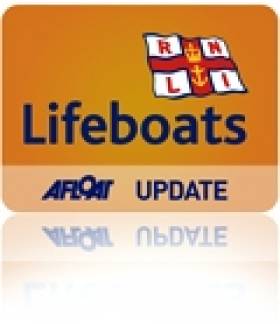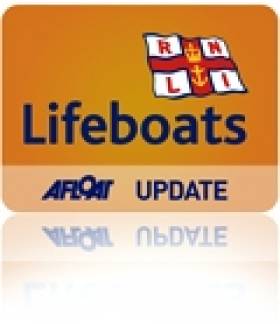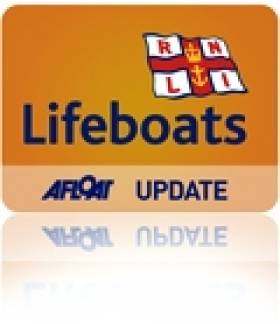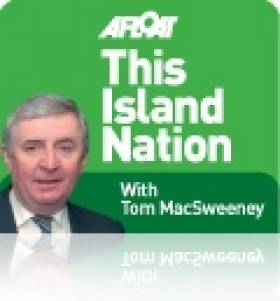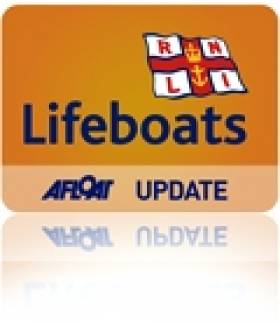Displaying items by tag: Union Hall
#RNLI - Union Hall RNLI rescued two men this afternoon (Monday 8 June) after their 18-foot pleasure boat got into difficulty off the coast of West Cork.
The volunteer crew was alerted shortly after 1.30pm by the Irish Coast Guard following a report that a pleasure boat was experiencing engine problems south of Castletownshend Harbour.
Within five minutes the inshore lifeboat, helmed by Chris Collins and with Anthony Walsh and Stephen Hurley onboard, was launched and made its way to the scene.
Weather conditions at the time were described as good with a Force 2-3 wind blowing and a moderate sea.
The lifeboat crew located the vessel a short time later at 1.56pm and observed that the two crew members onboard were in no immediate danger.
Union Hall RNLI proceeded to establish a tow line and bring the two men and their boat safely to Union Hall.
Speaking following the callout, John Kelleher, lifeboat operations manager at the station that's been operational since last September, said: "The crew onboard the pleasure boat did the right thing this afternoon by alerting the emergency services once they found themselves in difficulty.
"Our volunteers, who responded quickly, were delighted to be able to assist and we are pleased that everyone has now been returned safe and well to Union Hall."
Union Hall Lifeboat Answers First Callout
#RNLI - Last Thursday 13 November, Union Hall RNLI in West Cork responded to its first callout since becoming operational.
The volunteer lifeboat crew Anthony Walsh, Lee Miles and Tim Forde launched their B Class Atlantic 75 lifeboat, Maritime Nation, at 12.03pm to aid two small leisure craft drifting aground at Mill Cove in Rosscarbery.
No persons were found on board and the crew returned to the RNLI station shortly before lunchtime. Weather conditions were poor, with Force 4-5 winds and a south-easterly swell.
The callout marked the voluntary crew’s first emergency response since the lifeboat station became operational in Union Hall two months ago.
“I’m very happy with the response time and performance of the lifeboat crew and the shore crew," said lifeboat operations manager John Kelleher. "They have been training consistently every week, it’s a big commitment and we are glad to see that has paid off on our first call out."
Meanwhile, fundraising for the lifeboat continues with a weekly series of three Friday night table quizzes taking place in Union Hall, with the first tomorrow 21 November. A painting of the lifeboat by local artist Avril McDermott will be raffled at Dinty's Bar on the final quiz night on 5 December.
The fundraising branch has stocked local shops with RNLI Christmas cards and extend their thanks to Myross Rowing Club for a recent donation of €2,500, raised by members who competed in two charity rowing events.
RNLI to Trial New Lifeboat Station at Union Hall in Cork
#rnli – The Royal National Lifeboat Institution (RNLI) has announced that it is to trial a new lifeboat station at Union Hall in south west Cork. At a meeting of the RNLI Board of Trustees the decision was taken to establish an inshore lifeboat station at Union Hall for a trial period of 24 months. Following the evaluation the lifesaving charity will examine whether there is a case to establish a permanent lifeboat station at Union Hall.
Formal representations were made in May to the RNLI from the Glandore Harbour Inshore Lifeboat Committee for the establishment of a lifeboat station in the area. The committee was made up of individuals from the Union Hall and Glandore area representing the fishing industry, marine leisure and the local community.
The trial station will operate an RNLI B Class lifeboat. This lifeboat is a rigid inflatable boat measuring 7.3 metres and which can reach speeds of up to 32 knots. It is fast, manoeuvrable and very reliable and can operate in rough weather conditions. The inshore lifeboat complements the work of the larger all-weather lifeboats, which are based at the neighbouring RNLI lifeboat stations of Baltimore and Courtmacsherry. Baltimore RNLI also operates an inshore lifeboat. These declared search and rescue assets work with the Irish Coast Guard to save lives at sea.
The Union Hall lifeboat will come from the existing RNLI relief fleet and the station will be based on Union Hall Pier in Keelbeg. It is hoped to have the station fully operational and ready for service by the middle of next year. Work will shortly begin on recruitment and training.
Commenting on the decision RNLI Regional Operations Manager for Ireland and the Isle of Man, Martyn Smith said, 'The south west coast of Cork is an area of significant maritime activity. Sadly it has also witnessed its fair share of tragedy. While RNLI all-weather lifeboat cover is strong along the Cork coast we feel there is a strong case for the addition of an inshore lifeboat based at Union Hall.'
'This coastline has many inlets and cliffs that are suitable for the rapid response and shallow water operations of an inshore lifeboat. Therefore the charity has taken this significant step in search and rescue cover along the south west coast and we are grateful to the people of Union Hall and Glandore for their support on this project.'
Paddy O'Donovan, Chairman of the Glandore Harbour Inshore Lifeboat Committee added, 'We are delighted that the RNLI have taken the decision to trial an inshore lifeboat at Union Hall for 24 months. We felt there was a strong case for a lifeboat here and we worked hard to bring the community together to make that case to the RNLI. We are all very familiar with the lifesaving work of the lifeboat crews in Baltimore and Courtmacsherry and we want the lifeboat crew in Union Hall to work alongside them in making sure our coastline has strong search and rescue cover.'
The RNLI already operates 44 lifeboat stations around the coast and on inland waters in Ireland.
Six Thousand Milk Bottles, Barryroe Oil Progress & What Ships Might Look Like in 2020
#thisislandnation – Six thousand milk bottles in Bantry's inner harbour, Barryroe Oil progress, what will ships look like in 2020, disappearing manta rays, a new book scheme for seafarers, emotion in Union Hall, and the future of navigation and visual aids. Read on for this week's Irish and world maritime news developments.
SIX THOUSAND HARBOUR MILK BOTTLES
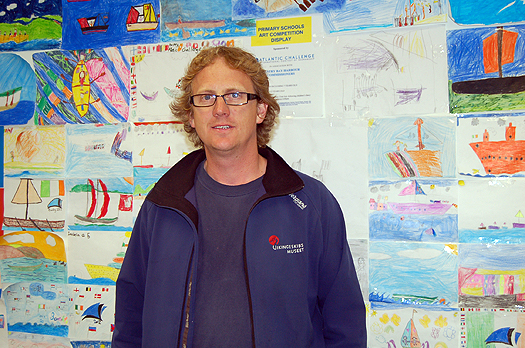
Diarmaid Murphy Bantry Atlantic Challenge organiser with schoolchildrens images of the event
The schoolchildren of Bantry created an impressive sight in the town's inner harbour where they used 6,000 two-litre milk bottles to build a replica boat for the Atlantic Challenge. Their project underlined the community-wide support for the event which brought hundreds of young sailors to the town for the past week.
Diarmaid Murphy, who led the event's organisational team, told me that the townspeople would like to see the inner harbour developed.
"It has considerable potential for marine leisure. The Challenge is a great event and we have been involved with it since 1988, so there is strong community support for what has been achieved here and the benefits the event, including taking part at home and abroad which has benefited our young people. The event also highlighted the potential of the inner harbour for the town."
The increase of interest in the Bantry Longboats which are used for the event is good to see. There are plans to build a new boat in Tullamore, so perhaps the inland waterways and the Shannon may see a longboat afloat.
BARRYROE OIL PROSPECTS
Last week I wrote about holding a vial of Barryroe Oil in my hand, pictured here and this week Provident Resources confirmed reports that the find has strong prospects. Its announcement will increase interest by the 'majors' in oil production and this is normal at this stage of the find. What benefit will Ireland get from the find? That question has been raised. The present situation is that 25 per cent of the net profits of a developed find, but note that is 'net' after exploration and development costs have been deducted, go to the State. Taxation changes could only be implemented for new investment. Don't expect, at least for the present, that Ireland is going to become as rich a country as Norway!
THE SHIP OF 2020
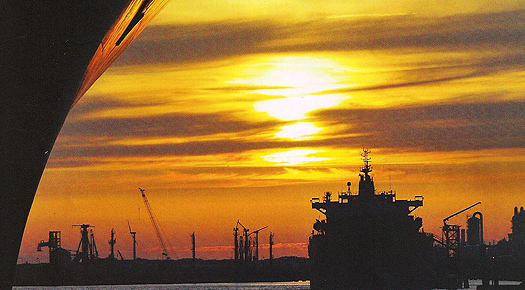
Technology has made major changes in ship design and operations, but reliance on modern electronic aids and monitoring and control systems will place extra pressure on watchkeepers who will have to avoid complacency in depending upon instrumentation and ensure that the shipboard "man-machine" interface works.
That observation is made in the International Journal of the Nautical Institute, Seaways. The Institute is the professional body for mariners. Rod Short who is Executive Secretary of GlobalMET Limited, writes: "Technological development and its impact on ship operations will continue and probably accelerate. On-board operational roles will have an increased element of systems monitoring and on-board management roles will move towards the building of leadership and teamwork, in particular developing teamwork among multi-cultural crews who may have varying standards of education and training."
He maintains that it is likely that a new ship in the 2015-2020 period will be "extensively automated with extensive use of electro-technology for all critical operations and will be more efficient, more economical and more environmentally friendly."
EMOTION IN UNION HALL
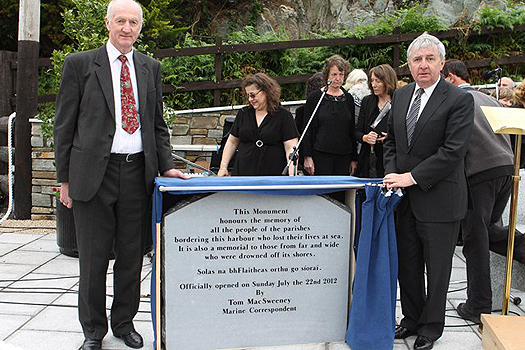
Marine correspondent Tom MacSweeney on right who unveiled the commemoration plaque and officially opened Union Hall Memorial Garden on Sunday July 22nd. On left is Mr Paddy O'Donovan, MC for the occasion and founder of the local community council.
The community of Union Hall have built an impressive memorial to the memory of seafarers at the entrance to the village which was the centre of the Tit Bonhomme trawler tragedy search last January. It is dominated by a 23ft. high anchor.
"On the plaques are recorded the drowning of 99 people, 76 who are named and the majority of whom came from three parishes around Union Hall," community leader Paddy O'Donovan told me. "The other 23 are unknown to us but would have been either Italian or English."
Some lost their lives while earning their living in fishing boats, others drowned in foreign waters in both World Wars, some were strangers whose cargo ships foundered off the coast, others drowned while engaging in watersports. The earliest tragedies recorded date back to February 1874. The memorial has been part-funded by Cork County Council, the rest raised by the community, many of whom I met, including relatives of those who died in the tragedy and the only Egyptian survivor, when I was honoured to unveil the memorial.
BOOK SCHEME FOR SEAFARERS
The Marine Society of the UK has launched a new crew book service for seafarers and ship operators. Books@Sea will equip ships with new paperbacks for seafarers. It is a new crew library service built on the experience gained by the Marine Society over many years.
"It offers a means of relaxation for seafarers and is a positive contribution to a safety culture at sea," said Captain Andy Winbow, Assistant Secretary of the International Maritime Organisation, at the launching of the service in London.
More information on: www.marine-society.org
E-NAVIGATION DEVELOPMENT
The Commissioners of Irish Lights will be working with user groups and stakeholders in the coming year to define how e-Navigation should be implemented in Ireland.
Captain Robert McCabe, Acting Head of Marine at CIL, believes that the role of visual Aids to Navigation will "undoubtedly decrease and radio navigation will come to the fore." In The Beam magazine of the Commissioners he indicates that 'Visual AtoN will still have a role 'for spatial awareness and the marking of some dangers' but they will reduce in both number and range.
"The risks of 'heads down' navigation (looking at the screen) are obvious. The challenge is to significantly improve 'heads up' navigation (looking out the window) and to continue to engage navigators with their surroundings while taking advantage of improved positioning, communications and charting. In the coming year we will work closely with user groups and stakeholders to define how e-Navigation should be implemented in Ireland and how we can maximise the benefit."
GENTLE GIANTS UNDER THREAT
The ocean's "gentle giants" as they are known, manta rays, are under threat because of increased fishing in Asian and South American waters to catch and kill them for their gills, used in soups and other dishes in Asia and traditional Chinese medicine.
The rays are pulled from the ocean, using either fine gill nets or spears. They are easy targets as they move slowly through the water. The United Nations Food and Agriculture Organisation says catches have quadrupled and the International Conservation for Nature has now classified the species as 'vulnerable.' They are in particular danger because they produce few young.
You can follow me for more marine news and comment on Afloat's Twitter and Twitter: @TomMacSweeney
And on Facebook – Afloat magazine and This Island Nation
Baltimore Lifeboat Tows Yacht to Union Hall
#RNLI – A yacht with engine difficulties just two miles east of Adams Island near Glandore Harbour, West Cork made a call for assistance as variable wind conditions impeded its progress. The alarm was raised last night at 20:04.
Baltimore lifeboat responded. The Tamar class lifeboat (with a top speed of 25 knots) made good speed to rendezvous with the distressed vessel.
Coxswain Kieran Cotter assessed the situation of the two male yachtsmen on board the 35–foot yacht and decided the best course of action was to tow the yacht into Union Hall 65 minutes away. Having secured the yacht safely the lifeboat returned to Baltimore.
On board the lifeboat were Coxswain Kieran Cotter, Cathal Cottrell, Micheal Cottrell, Jerry Smith, Diarmuid Collins and Brian McSweeney
Coastguard 'Overwhelmed' By Response to Glandore Search Appeal
#NEWS UPDATE - The Irish Coast Guard told RTÉ News that it has received an "overwhelming" response from the diving community to its appeal to join the search in West Cork for two missing fishermen.
Skipper Michael Hayes and crewman Saied Ali Eldin are still missing after the fishing vessel Tit Bonhomme ran aground in rough seas near Adam's Rock at the mouth of Glandore Harbour.
Only one of the six-person crew - 43-year-old Abdul Mohammed – is confirmed to have survived. The bodies of Kevin Kershaw (21) and Attia Shaban (26) were recovered last week, while the remains of Wael Mohammed (35) were found by civilian divers near the wreck site last Sunday.
Coastguard manager Declan Geoghegan said that search teams now have the 48 divers required to conduct an exhaustive search of the wreck area and urged further volunteers not to travel for the moment.
The search will concentrate on the waters between Adam's Rock and Long Point, where much of the debris from the trawler has washed up.
RTÉ News reports that more than 200 volunteers are assisting the coastal search by boat and on land, which is being co-ordinated from the village of Union Hall.



























